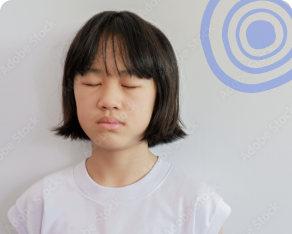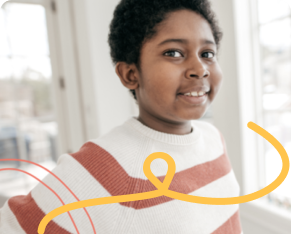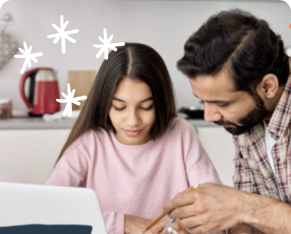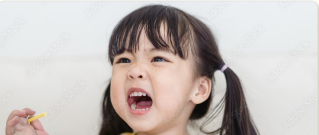ADHD in Children & Adolescents
![]()
What is ADHD?
![]()
ADHD, also known as ADD, is the most common behavior disorder in children. It can make it hard for kids to sit still, pay attention, or make good decisions. Because of this, children with ADHD might have trouble in school, at home, or with friends.
Famous People Who Have ADHD

Michael Phelps

Will Smith

Emma Watson
Justin Timberlake
![]()
Understanding the Diagnosis
How common is ADHD in children and adolescents?
ADHD affects up to 10% of school-aged children. About 70% of these children will continue to have ADHD as teenagers, and about half will still have it as adults. While hyperactivity and impulsivity often decrease with age, attention problems can last longer and may even get worse as school becomes more challenging.
What are the symptoms of ADHD?
Children with ADHD often have one or more of the following symptoms:
- Increased activity (hyperactivity): A child might have trouble sitting still or playing quietly.
- Acting impulsively: A child might interrupt others or do things without thinking first.
- Trouble paying attention: A child might be forgetful, lose things, or have trouble finishing a project.
These symptoms can make it hard for children to succeed in school, at home, and with friends.
How do the symptoms of ADHD differ from typical childhood behavior?
Attention, impulsivity, and energy levels are normal traits in all children and change as they grow. Younger kids usually have shorter attention spans and more energy than older kids. However, ADHD is considered when a child's attention span is very low and their impulsivity and hyperactivity are very high compared to their peers of the same age and gender. These symptoms must also directly affect their learning, academic performance, behavior at school and home, friendships, and family life. When a child's attention is very low and their impulsivity and hyperactivity are very high, and these traits cause significant problems, we consider a diagnosis of ADHD.
What causes ADHD?
Research has found that ADHD is related to how certain chemical messengers, called neurotransmitters, work in the brain. In people with ADHD, neurotransmitters like dopamine and norepinephrine are less available in specific parts of the brain. This affects how the brain controls attention, impulses, and activity levels.
How is ADHD diagnosed?
Diagnosing ADHD involves two main steps. First, we look for signs like a very low attention span, poor organization, and high impulsivity and hyperactivity compared to what is typical for their age and gender. Next, we check if these behaviors are causing problems in schoolwork, relationships with family and friends, and emotions. These two steps are accomplished by a clinical assessment of your child and gathering information from family and teachers about their emotions, school performance, and behavior.
Diagnosing ADHD can sometimes be more challenging because symptoms can overlap with other conditions like anxiety and oppositional behavior. Different caregivers might give contradictory histories. Traits like inattention, impulsivity, and hyperactivity are normal to some extent in everyone, and at times it is difficult to determine just based on clinical assessment if they are significant enough to suggest ADHD. In these cases, neuropsychological testing is used. This testing helps by objectively measuring these traits and comparing them to other children of the same age and gender. [Click here to learn more about Neuropsychological testing for ADHD at MindWeal.]
This thorough process ensures an accurate diagnosis and helps us provide the best support for your child.
|
|
Treating ADHD in Children & Adolescents
Will my child’s ADHD pass without treatment?
If your child’s ADHD symptoms, such as inattention, impulsivity, and hyperactivity, are affecting their learning, behavior, and emotions, it will not get better on its own. Active interventions are necessary to improve their current functioning and to prevent future problems. Even if your child’s ADHD doesn’t seem severe now, leaving it untreated can lead to later issues, such as:
- Academic underachievement: Struggling in school can affect their future opportunities and achievements.
- Emotional struggles: Constant academic challenges can lead to low self-esteem, depression, and anxiety.
- Behavioral issues: Untreated ADHD can result in oppositional behavior, trouble with relationships, motor vehicle accidents, and not following rules.
- Substance use problems: There is a higher risk of cigarette and substance use issues.
Many research studies in the United States and other countries show that early and continuous treatment of ADHD can reduce these negative outcomes. Treating ADHD helps children succeed and improves their quality of life.
How is ADHD treated?
For preschoolers (ages 3 to 5) with ADHD symptoms, parent training and behavior modification techniques are recommended first. These methods help change behavior patterns at home and school. Medication is considered only if significant behavior problems continue after trying these techniques.
For school-aged children, research shows that medication is usually the most effective treatment. Combining medication with parent training and behavior modification techniques often leads to better outcomes. Studies show that some children do well with just medication, while others benefit from adding parent training and behavioral therapies.
Using the right combination of treatments can help your child succeed at home, in school, and in their relationships.
Which psychotherapies are effective in treatment of ADHD?
For all ages, medication is often used along with other treatments, such as:
- Counseling: Structured talk therapies that help children and families understand and cope with ADHD. It helps children and their parents identify and unlearn problem behaviors (for example, getting mad and yelling at others) while learning new healthier behaviors and ways to cope with stress.
- Parent-Child Interaction Therapy (PCIT): It focuses on enhancing the parent-child relationship by encouraging positive interactions and teaching parents effective discipline techniques and ways to manage your child's challenging behaviors.
- Behavior modification: Uses rewards and consequences to encourage good behavior.
- Family therapy: Improves communication and problem-solving within the family.
Using a combination of treatments can provide the best results for children with ADHD.
|
|
Taking Medications for ADHD
Are medications effective for ADHD in children & adolescents?
ADHD medications are the most successful intervention for ADHD and are the most studied medication treatments in all of pediatrics. About three-quarters of children and adolescents respond well to one or more of these medications. While not every symptom may go away completely, you should see noticeable improvement.
In general, medications can reduce ADHD symptoms by 40–50%. This often leads to better performance at school, improved homework completion, and better interactions with peers and family. However, medication alone does not teach organizational skills or help with learning disabilities. These need to be addressed with counseling and extra support from parents and teachers.
What types of medications are available to treat my child’s ADHD?
Several different categories of medication have proven to be effective for treatment of ADHD:
Stimulants: Stimulants are the most effective and most commonly prescribed medications for ADHD. They include both methylphenidate (Ritalin, Concerta, Focalin, and others) amphetamine (Adderall, Vyvanse, and others)
Nonstimulants: If your child does not respond to and/or cannot tolerate stimulants because of side effects, there are a variety of nonstimulant medications that may be considered. In general, the non-stimulants are somewhat less effective than the stimulants; however, they tend to treat ADHD throughout the day with minimal effects on appetite or sleep. Sometimes a non stimulant may be used together with a stimulant medication to improve effects and reduce side effects. Non stimulant medications include Guanfacine, Clonidine, Atomoxetine (Strattera) & Viloxazine (Qelbree)
Second-line nonstimulants: These medications are not FDA approved for the treatment of ADHD but have been shown in research studies and in clinical practice to be useful options if the stimulants or approved nonstimulant medications do not work well for your child or have too many side effects. Second-line non stimulants include Bupropion (Wellbutrin) & Modafinil (Provigil)
How are medications chosen?
Choosing the right medication for your child's ADHD is a careful process. We recommend medications that have been proven to work in research studies and follow guidelines from national organizations like the American Academy of Child & Adolescent Psychiatrists and the American Academy of Pediatrics.
Our providers consider your child's age, past medications and their effects, family history of medication responses, and the preferred form of medication (capsule, tablet, or liquid). They also look at your child’s unique circumstances, such as which symptoms of ADHD are more prominent and where (school or home) they are most affecting them.
For school-aged children, stimulants are usually the first choice. If one stimulant doesn’t work or causes side effects, we try another type. Research shows that methylphenidate and amphetamine can work differently in the brain, so one might be more effective or have fewer side effects for your child.
If stimulants don’t work or cause too many side effects, we consider nonstimulant medications. Although non stimulants are generally less effective than stimulants, they can treat ADHD throughout the day with minimal effects on appetite or sleep. Sometimes, a non stimulant is used with a stimulant to improve results and reduce side effects.
For preschool children (ages 3 to 5), guanfacine and clonidine might be considered first because younger kids are more likely to have side effects from stimulants. These medications are very effective for impulsivity and hyperactivity, which are often major concerns in this age group.
How is the medication dose selected and changed?
To find the right dose for your child’s medication, we start with a low dose and gradually increase it. We do this until you and your child's teachers notice a significant improvement in ADHD symptoms or until side effects prevent further increases. During treatment, you and your child will have regular check-ins with the clinician. These meetings help us see how well the medication is working and if there are any side effects.
How long does medication take to work?
It depends on the type of medication chosen.
Stimulants: You will likely see effects on your child’s attention and behavior within 30–60 minutes of taking the medication. For short-acting (immediate-release) stimulants, these effects usually last about 4 hours, often requiring 2 or 3 doses per day. Many parents prefer long-acting (extended-release) stimulants so their child doesn’t need a dose during the school day. Extended-release stimulants start working within an hour and last 10–12 hours, depending on the form. Often, a single morning dose lasts through the school day and into the evening. Sometimes, a combination of short- and long-acting stimulants is prescribed to cover the entire day.
Guanfacine and Clonidine: You will likely see effects on your child’s attention and behavior within 30–60 minutes of taking the medication. For short-acting (immediate-release) formulations, these effects usually last about 4 hours, often requiring 2 or 3 doses per day. Many parents prefer long-acting (extended-release) formulations so their child doesn’t need a dose during the school day. Guanfacine extended-release starts working within an hour and lasts up to 24 hours, though the majority of benefit is noted within the first 12 hours. Clonidine extended-release starts working within an hour and lasts up to 12 hours, though the majority of benefit is noted within the first 8 hours.
Atomoxetine, Qelbree, Bupropion: With these medications, you might see some improvement in 2 to 4 weeks, with more progress over 8 to 12 weeks. Some children feel better quickly with a low dose, while others might need a higher dose. We start with the lowest dose to help children get used to the medication and reduce side effects. If it doesn’t help, we increase the dose. Finding the best dose can take 8 to 12 weeks.
How do I know that the medication is working?
You will know that the medication is working if you notice these improvements in your child:
- They can pay more attention and stay focused on tasks.
- They are more organized with their daily activities and responsibilities.
- They make more thoughtful and mindful decisions.
- Their energy levels are balanced and not causing disruptions.
- Their behavior has improved both at school and at home.
- Their academic performance and grades are improving.
- They have better relationships with friends and family members.
- They show increased confidence and a better sense of well-being.
To make sure the treatment is working, we use a wellness score. This score combines what the provider sees in your child's symptoms, what you notice about their overall wellness, and how your child feels about themselves. Be sure to complete the wellness questionnaire before each visit so we can track your child's progress and make any needed changes to their treatment plan.
Can the medications cause side effects and how are they managed?
Yes, your child may experience some side effects from ADHD medications, but most can be managed and may improve over time. Here’s a breakdown of common medications and their side effects:
Stimulants: Common side effects include loss of appetite leading to weight loss, difficulty falling asleep, bellyaches, nausea, and irritability. Less frequent side effects include becoming very quiet and over-focused (sometimes called the “zombie” effect), tics, anxiety, and skin picking. We start medications at a low dose to help minimize these side effects, which often improve as your child gets used to the medication. One rare risk is heart rhythm disturbances, which is more likely in children with a genetic predisposition. We carefully review your child’s medical and family history and monitor for heart issues. If heart rhythm problems are present, we avoid stimulants and consider non-stimulants.
Guanfacine & Clonidine: The most common side effect is drowsiness, which usually improves with time. Starting these medications at low doses helps minimize this effect. Higher doses can cause dizziness and a slow heart rate, so we increase the dose gradually. If stopped abruptly, these medications can cause a temporary increase in blood pressure, so they should be tapered off slowly.
Atomoxetine (Strattera): Common side effects include nausea, bellyaches, and excessive tiredness. Most side effects are mild and improve over time. We start with a low dose to help minimize these side effects.
Viloxazine (Qelbree): Common side effects include excessive tiredness and nausea. Most side effects are mild and improve over time. We start with a low dose to help minimize these side effects.
Bupropion (Wellbutrin): Common side effects include nausea, dry mouth, constipation, headache, and stomach upset. Most side effects are mild and improve over time. We start with a low dose to help minimize these side effects.
To reduce the odds of these side effects and to effectively manage them, it's crucial to follow the prescribed dosage and schedule and to have regular check-ins with your child’s provider.
On the day your child’s medication is prescribed, you will receive a separate email with a link to detailed information about the medication. This email will explain the medication's benefits and possible side effects, provide tips on how to manage them, and advise when to contact your provider.
Do these medications increase the risk of substance abuse?
No, ADHD medications do not increase the risk of substance abuse. In fact, research shows that treating ADHD with medication can actually reduce the risk of future substance abuse. When ADHD symptoms are well-managed, children and adolescents are less likely to turn to drugs or alcohol to cope with their challenges. They are also more likely to make thoughtful and less impulsive decisions, further reducing the risk of substance use. By effectively managing ADHD symptoms, medications help children succeed in school, build better relationships, and develop healthy habits, all of which decrease the likelihood of substance abuse later in life. Stimulant medications are carefully prescribed and monitored by doctors to ensure they are used safely.
Are medications prescribed for ADHD habit-forming?
When used properly under a doctor’s supervision, ADHD medications do not lead to dependency. It’s important to follow the prescribed dosage and schedule, and to have regular check-ins with your child’s doctor to monitor progress and watch for any potential misuse or diversion.
How can these medications be misused or diverted and how can that be prevented?
Stimulant medications are classified as Schedule II-controlled substances and have the potential to be misused or diverted, particularly among high school and college students, especially those who are also using other substances. Misuse includes taking medication in larger amounts, more often, or in a different way than prescribed. Diversion involves giving, trading, or selling prescribed medication to others.
To prevent misuse and diversion, MindWeal follows strict guidelines, including an initial negative urine drug screen (UDS) for children ages 14 and older before starting stimulant medication, and annual negative UDS for patients ages 14 and older on stimulant medications. To further reduce the risk of misuse and diversion, parents should stay actively involved in their child's treatment, carefully monitor the medication and store it securely, attend all visits with the child's provider, and report any suspicious changes in behavior.
Are there medications that can help with sleep problems that might be due to ADHD?
Children with ADHD may have trouble sleeping. They might be too energetic to fall asleep and may move a lot during sleep, waking up frequently through the night. Good sleep habits, known as sleep hygiene, can help all children with sleep issues. If these habits don't work, your provider may prescribe medications to help your child fall asleep and stay asleep.
Here are some commonly used medications:
- Melatonin: Often the first treatment used to help regulate sleep.
- Clonidine: Can be very effective as it also helps reduce hyperactivity at night.
- Antidepressants: Medications like Trazodone and Mirtazapine can also be helpful for sleep.
These medications should only be taken as prescribed by your provider to ensure they are safe and effective for your child. By improving sleep, your child can feel more rested and better able to manage their ADHD symptoms during the day.
|
|
![]()
Other treatments for ADHD
Implementing lifestyle changes can significantly help manage your child’s ADHD symptoms. Here are some key areas to focus on:
-
-
Regular Physical Activity: Encourage your child to participate in physical activities they enjoy, such as playing outside, sports, dancing, or simply going for walks. Exercise can help improve focus, reduce hyperactivity, and boost mood.
-
Healthy Diet: Provide balanced meals with plenty of fruits, vegetables, whole grains, and lean proteins. Avoid foods high in sugar and additives. A healthy diet supports brain function and overall health, which can help manage ADHD symptoms.
-
Consistent Sleep Patterns: Make sure your child has a regular bedtime routine and gets enough sleep each night. Consistent sleep patterns can improve attention, behavior, and overall mood.
-
Limit Screen Time: Reduce the amount of time your child spends on electronic devices. Encourage other activities like reading, drawing, playing a musical instrument, or joining clubs. Limiting screen time can prevent overstimulation and help improve focus & attention.
These lifestyle changes, along with medical treatment, can significantly improve your child’s ability to manage ADHD symptoms and enhance their overall well-being.
-
|
|

Parent Guide: Supporting Your Child with ADHD
Parenting a child with ADHD can be challenging, but with the right strategies and support, you can help your child manage their symptoms of ADHD effectively. Here are some practical tips to support your child in overcoming their ADHD and building resilience. Remember, small steps lead to big changes, and your support makes all the difference.
Creating a Supportive & Nurturing Environment
-
- Maintain Open Communication with Your Child: It’s essential to create a safe space where your children feel comfortable sharing their thoughts and feelings without fear of judgment. Encourage them to express their emotions, helping them understand that talking about feelings is a normal and healthy part of life. By actively listening and validating their emotions, you build a stronger bond with your children, enhancing their overall mental and emotional wellbeing.
- Show Empathy and Understanding: Comforting a child who is upset or stressed involves acknowledging their emotions and showing compassion. Even if you don’t agree with their perspective, validating their feelings reassures them that it’s okay to experience a range of emotions. This approach builds trust, strengthens your relationship, and creates a safe space for them to express themselves.
- Establish Structure & Routines: Predictable routines are crucial for children’s development. Consistent daily activities like meals, homework, and bedtime provide a sense of security and stability, promoting their emotional wellbeing. Regular routines make it easier for children to adapt to changes and transitions.
- Designate a Specific Study Area: Set up a quiet, clutter-free area dedicated to studying or homework. This helps in minimizing distractions and improving focus.
- Structured Homework Time: Set a specific time each day for homework or studying. Consistent study times help establish good habits and reduce procrastination.
- Offer Praise & Rewards: Celebrate your child's successes. Focus on praising the effort, not just the outcome. Review our guide “Using Praise: A Positive Parenting Skill” to learn how to use praise effectively to encourage positive behavior in children. Reward your child's efforts to face anxiety-producing situations. Focus on rewarding the effort, not the outcome.
- Maintain Open Communication with Your Child: It’s essential to create a safe space where your children feel comfortable sharing their thoughts and feelings without fear of judgment. Encourage them to express their emotions, helping them understand that talking about feelings is a normal and healthy part of life. By actively listening and validating their emotions, you build a stronger bond with your children, enhancing their overall mental and emotional wellbeing.
Strengthen your relationship with your child by following the Child-Directed Interaction (CDI) component of Parent-Child Interaction Therapy (PCIT), as outlined in our Parent Education Guide: Understanding Parent-Child Interaction Therapy (PCIT). CDI focuses on building a positive relationship through play and is most effective for younger kids aged 2-7.
Enhance Their Organizational Skills
-
- Organize School Supplies and Personal Belongings: Encourage your child to keep school supplies and other personal stuff organized and easily accessible. Use labeled bins, folders, or drawers to help your child find what they need quickly and efficiently.
- Break Tasks into Smaller Steps: Large tasks can be overwhelming. Breaking them down into smaller, manageable parts can help children stay focused and feel less daunted.
- Encourage Regular Breaks: Short breaks during tasks can help maintain concentration and prevent burnout. Activities like stretching, walking, or a brief outdoor activity can be beneficial.
- Set Clear Expectations and Rules: Clearly communicate expectations and rules regarding behavior and tasks. Consistency in these expectations helps children understand what is required of them.
- Use Technology Wisely: Implement educational apps or tools that can assist in organization and learning. However, also ensure to limit screen time to prevent distractions.
- Involve Them in Planning: Involve your child in planning their schedules or organizing their tasks. This empowers them and improves their self-management skills.
- Organize School Supplies and Personal Belongings: Encourage your child to keep school supplies and other personal stuff organized and easily accessible. Use labeled bins, folders, or drawers to help your child find what they need quickly and efficiently.
 Teach Time Management and Prioritization
Teach Time Management and Prioritization
-
- Time Management Tools: Teach the use of timers or alarms to manage time effectively. This can help children understand the concept of time and stay on task.
- Prioritize Tasks: Teach your child to prioritize tasks by importance and urgency. This skill helps them focus on what needs to be done first, improving their organizational abilities.
- Set Realistic Goals: Help your child set achievable goals, whether daily, weekly, or longer-term. Celebrate when these goals are met to encourage continued effort and improvement.
- Time Management Tools: Teach the use of timers or alarms to manage time effectively. This can help children understand the concept of time and stay on task.
Teaching Life Skills
-
- Teach Responsible Decision Making: Guide your child in making thoughtful, well-informed decisions. Discuss potential consequences of various choices and encourage critical thinking about how their decisions affect themselves and others. Visual aids, like drawing or writing outcomes, can help them understand the impact. This approach fosters responsibility and accountability.
- Help with Problem Solving: Support your child in developing coping strategies and problem-solving ideas. Brainstorm solutions together and discuss the pros and cons of each option. Encourage gradual independence by providing less assistance over time, boosting their confidence and self-reliance.
- Model Problem Solving: Demonstrate positive coping and problem-solving strategies in your own life. Let your child see how you handle challenges effectively. By witnessing your approach, your child learns valuable problem-solving techniques and gains confidence in their ability to manage their own challenges.
- Teach Responsible Decision Making: Guide your child in making thoughtful, well-informed decisions. Discuss potential consequences of various choices and encourage critical thinking about how their decisions affect themselves and others. Visual aids, like drawing or writing outcomes, can help them understand the impact. This approach fosters responsibility and accountability.
Encourage Healthy Habits
-
- Promote Physical Activity: Physical activity is essential for maintaining good mental health, improving cognitive function, and enhancing sleep quality. Incorporate physical activity into their daily routines to boost their overall quality of life.
- Ensure Balanced Nutrition: A balanced diet is vital for your child’s physical and emotional health. Ensure they consume a variety of foods from all food groups to avoid mood, sleep, and behavioral disturbances.
- Prioritize Good Sleep: Adequate sleep is crucial for emotional wellbeing. Children under 12 need 10-13 hours of sleep, while teenagers need 8-10 hours. Teach your child to prioritize good sleep habits for overall health and wellness.
- Promote Physical Activity: Physical activity is essential for maintaining good mental health, improving cognitive function, and enhancing sleep quality. Incorporate physical activity into their daily routines to boost their overall quality of life.
Nourishing Social-Emotional Development
-
- Teach Emotional Awareness: Help your child recognize and talk about their emotions. Activities like reading books on emotions or using picture cards with different facial expressions can be effective. Discussing scenarios and asking how they would feel in various situations can develop their emotional intelligence.
- Develop Social Skills: Model positive social interactions to teach your child skills like listening, sharing, and cooperating. Encourage participation in community activities like team sports or volunteer work to practice these skills and learn effective communication.
- Teach Emotional Awareness: Help your child recognize and talk about their emotions. Activities like reading books on emotions or using picture cards with different facial expressions can be effective. Discussing scenarios and asking how they would feel in various situations can develop their emotional intelligence.
Teaching Coping Strategies
-
- Teach Relaxation Practices: Introduce relaxation techniques like deep breathing, progressive muscle relaxation, or mindfulness to help manage stress. Encourage regular practice to make these techniques a familiar part of their emotional management toolkit.
- Promote Creative Outlets: Encourage activities like drawing, writing, or playing music to help children express emotions and relieve stress. Creative outlets can boost self-esteem, foster social connections, and provide a sense of control over their emotions.
- Model Emotional Regulation: Children learn by observing their parents. Show them how to manage emotions calmly and resiliently. Your reactions to challenging situations serve as a model for them to cope with their own emotions.
- Teach Relaxation Practices: Introduce relaxation techniques like deep breathing, progressive muscle relaxation, or mindfulness to help manage stress. Encourage regular practice to make these techniques a familiar part of their emotional management toolkit.
Managing Your Child’s Behavior Effectively
-
-
Learn Effective Disciplining Techniques: Follow the Parent-Directed Interaction (PDI) component of Parent-Child Interaction Therapy (PCIT), as outlined in our Parent Education Guide: Understanding Parent-Child Interaction Therapy (PCIT).
-
Set Up Rules and Consequences: Establish clear rules and consequences for behavior in advance to prevent arguments and ensure everyone knows what to expect. Pick your battles by focusing on the most important areas where structure is needed. Use natural or logical consequences that match the behavior. For example, if a child leaves their bike outside overnight, they lose bike privileges for a set period. For more tips on encouraging positive behaviors and reducing undesired ones, review our “Parent's Guide to Creating a Behavior Modification Plan.”
-
Giving Clear and Specific Commands: Click here to learn how to give clear, specific, and age-appropriate commands that are easy for your child to understand and follow.
-
Implementing Effective Timeouts: Click here to learn more about how to give effective timeouts. Use timeouts as a consequence for non-compliance. Learn to implement them effectively, ensuring they are brief, consistent, and followed by a return to positive interactions.
-
Monitoring Your Child’s Mental Health
-
- Stay Informed About Mental Health: Educate yourself about ADHD in children to recognize early warning signs and provide timely support.
- Conduct Regular Check-Ins: Have regular check-ins to discuss progress and challenges in organization, behavior, and focus. Provide constructive feedback and listen to their experiences.
- Observe Behavior Changes: Pay close attention to shifts in behavior, academic achievement, sleep patterns, and mood. If you notice any concerning changes, don't hesitate to seek professional help.
- Stay Informed About Mental Health: Educate yourself about ADHD in children to recognize early warning signs and provide timely support.
Working with Your Child’s Support System
-
- Maintain Your Mental Health: Recognize the impact of your child’s depression on your own well-being. Engage in self-care activities like meditation, yoga, and maintaining social connections. Seek counseling if needed to manage your own emotional health.
- Engage with Educators: Build relationships with your child’s educators to stay informed about any issues. Regular check-ins can help identify struggles early and provide opportunities for intervention.
- Advocate for Your Child’s Needs: If your child’s provider suggests school accommodations, be proactive in ensuring these needs are met.
- Seek Professional Guidance: If you notice worrying changes in your child’s behavior, learning or mood, seek guidance from mental health professionals. Early intervention is crucial in addressing mental health concerns and supporting your child’s wellbeing.
- Maintain Your Mental Health: Recognize the impact of your child’s depression on your own well-being. Engage in self-care activities like meditation, yoga, and maintaining social connections. Seek counseling if needed to manage your own emotional health.
Self-Care for Parents
-
- Maintain Your Mental Health: Recognize the impact of your child’s depression on your own well-being. Engage in self-care activities like meditation, yoga, and maintaining social connections. Seek counseling if needed to manage your own emotional health.
By implementing these strategies, you can effectively support your child through their challenges with ADHD, while also taking care of your own mental health needs.

Child Guide with links to DIY therapy tools
At MindWeal, we have discovered that empowering children with self-guided care enables them to take control of their well being and actively participate in their treatment, leading to better outcomes. Here are some helpful resources included in this document:

DIY Guide for Kids
Deep Breathing Exercises

DIY Guide for Kids
Progressive Muscle Relaxation for Children & Adolescents

DIY Guide for Kids
Learn & Practice DBT skills

DIY Guide for Kids
How to Practice Mindfulness

DIY Guide for Kids
How to Practice Distress Tolerance

DIY Guide for Kids
How to Practice Emotion Regulation

DIY Guide for Kids
How to Practice Interpersonal Effectiveness

Common questions you may have as a Parent
How can I talk to my child about their feelings without making them feel judged?
Approach conversations with empathy and patience. Ask open-ended questions to encourage sharing. Listen actively, showing that you understand and care. Avoid being critical or dismissive. Let your child know it’s okay to feel the way they do and that you are there to support them.
What should I do If my child refuses to take medication?
Discuss their concerns openly and involve them in treatment decisions, understanding their fears to help address them. Emphasize the benefits of medication in managing anxiety and improving quality of life. Use the DESC technique to communicate effectively and foster cooperation—click here for a guide on implementing this method. If necessary, consult their healthcare provider to explore alternative treatment options.
How Can I Make Sure That My Child's School Is Supportive of Their Needs?
Maintain regular communication with your child, their teachers, and school counselors to understand how ADHD symptoms affect their school functioning. If ADHD is impacting your child, discuss with their provider and counselor whether school accommodations would be helpful. If recommended, work closely with school staff to develop an individualized education plan (IEP) or 504 plan. Ensure the school provides the necessary accommodations. Being proactive helps create a supportive school environment.
Have more questions? Check our FAQ section
.png)
After-hours Crisis Care
Our emergency same-day appointments minimize after-hours crises. But, if you’re in crisis outside our working hours (Mon to Fri from 8 AM to 5 PM), call 911 or visit the nearest ER for immediate help and safety assessment.
Resources
In Case of an Emergency or Mental Health Crisis
A mental health emergency occurs when your child's behavior poses a danger to A mental health emergency happens when your child's behavior poses a danger to themselves or others, or when they cannot care for themselves and function normally. Signs of a mental health emergency include thoughts of suicide, severe emotional distress, or a mental health or substance use crisis. In these situations, it's crucial to know who to contact for immediate help.
Here are some essential emergency contacts:
-
Call 911 or go to your nearest emergency room.
-
Call 988: This hotline connects you to trained crisis counselors who can provide support for mental health-related distress, including thoughts of suicide, mental health or substance use crises, and any other kind of emotional distress.
-
Crisis Text Line: Text MHA to 741741 to receive free, text-based 24/7 support from a trained Crisis Counselor.
By having these resources readily available, you can act quickly and effectively during a mental health crisis, ensuring the safety and well-being of your child.
Other Resources
- CHADD (Children and Adults with Attention-Deficit/Hyperactivity Disorder)
-
- Website: chadd.org
- Overview: Offers resources on ADHD symptoms, diagnosis, and treatment. Provides local chapters, online communities, and webinars for parents and children.
- ADDitude Magazine
-
- Website: additudemag.com
- Overview: Features articles, expert advice, and personal stories about managing ADHD. Covers behavior management, school accommodations, and parenting strategies.
- Understood
-
- Website: understood.org
- Overview: Provides resources for parents of children with ADHD, including articles, videos, and tools. Focuses on behavior management, school support, and academic success.
For Parents
- "Taking Charge of ADHD: The Complete Authoritative Guide for Parents" by Russell A. Barkley. A well-respected guide that provides parents with the tools they need to manage ADHD effectively. It includes detailed information on diagnosis, treatment options, and strategies for behavior management.
- "The ADHD Parenting Handbook: Practical Advice for Parents from Parents" by Colleen Alexander-Roberts. This book offers practical advice and strategies from parents who have navigated the challenges of raising a child with ADHD. It includes tips on discipline, organization, and communication.
- "Driven to Distraction: Recognizing and Coping with Attention Deficit Disorder from Childhood Through Adulthood" by Edward M. Hallowell and John J. Ratey. This comprehensive guide covers ADHD from childhood to adulthood, offering insights and practical strategies for managing the condition. It's a valuable resource for understanding the various aspects of ADHD.
- "Smart but Scattered: The Revolutionary 'Executive Skills' Approach to Helping Kids Reach Their Potential" by Peg Dawson and Richard Guare. This book focuses on helping children develop executive functioning skills that are often lacking in kids with ADHD. It provides practical strategies for improving organization, time management, and problem-solving skills.
- "The Explosive Child" by Ross W. Greene. This book offers a new approach for understanding and parenting easily frustrated, chronically inflexible children. It provides practical strategies to help parents manage challenging behaviors.
For Children
- "Mrs. Gorski, I Think I Have the Wiggle Fidgets" by Barbara Esham. This book follows David, a boy with ADHD who struggles to focus in class. It encourages children to use their creativity to manage their behaviors.
- "This Morning Sam Went to Mars: A Book About Paying Attention" by Nancy Carlson. This story is about Sam, a boy who daydreams in class, and offers tips on staying organized and focused, promoting healthy habits.
- "Good Morning Yoga: A Pose-by-Pose Wake Up Story" and "Good Night Yoga: A Pose-by-Pose Bedtime Story" by Mariam Gates. These books use yoga to help children with ADHD become calmer and more focused through simple poses and breathing exercises.
For Adolescents
- "Smart but Scattered Teens: The 'Executive Skills' Program for Helping Teens Reach Their Potential" by Richard Guare, Peg Dawson, and Colin Guare. This book offers strategies to help teens develop executive functioning skills such as organization, time management, and goal setting. It's filled with practical advice to help teens harness their strengths and manage ADHD effectively.
- "The Survival Guide for Kids with ADHD" by John F. Taylor. Written in a straightforward and engaging style, this guide provides teens with practical tips for managing ADHD symptoms, handling schoolwork, and navigating social situations. It empowers teens to take charge of their ADHD and succeed.
- "ADHD: A Teen's Guide to Thriving" by Mark Bowers. This book provides teens with tools and strategies to manage their ADHD symptoms and thrive in school and everyday life. It covers topics such as goal setting, self-advocacy, and developing healthy habits.
For College Students
- "ADD and the College Student: A Guide for High School and College Students with Attention Deficit Disorder" by Patricia Quinn. This book specifically addresses the challenges faced by college students with ADHD. It offers practical advice on managing coursework, staying organized, and developing effective study habits. It’s a comprehensive guide to help students transition smoothly into college life.
- "The ADHD Guide to College Success: Strategies for Students, Educators, and Parents" by Dr. Patricia O. Quinn. This book provides a detailed roadmap for college students with ADHD, covering everything from academic strategies to social skills and self-care. It includes input from educators and parents, making it a well-rounded resource for managing ADHD in a college setting.
- ADHD reWired: This podcast blends expert insights, personal ADHD stories, and practical strategies to help listeners thrive with ADHD.
- Hacking Your ADHD: This podcast covers a range of topics, from emotional regulation to productivity tips, offering a pragmatic approach to living with ADHD.
- I Have ADHD: This podcast explores various aspects of living with ADHD, including challenges related to motherhood, sleep, and self-care.








